Post Thanksgiving week started out in a brisk pace, where I began working on certain oversize items, which required to be re-shot. Since the Hasselblad Camera had some functional issues, we had to shift to the Canon-Rebel camera, which required a different setting in order to take pictures indoors. Through the middle of the week, I started working on my culminating presentation. While finding out information for the presentation, an interesting fact that I was able to figure out was that there is no valid biography of Willis S. Jones. Finding out about Willis S. Jones was an eye-opener, which I plan to present during my presentation.
Boulder Canyon Project Relies on Old and New Power to Pave Ways
During the Boulder Canyon portion of these water projects, old and new technology was used when deemed necessary. It is interesting to note the use of diesel-powered compressors to level grounds for creating highways and pathways for railroads, then opting for older steam-powered locomotives to haul building materials to the dam’s construction site.
The irony is not lost in using the new methods to make way for the old.
Below are pictured the 19th-century style, 90-ton locomotive used in this 1929 report, hauling materials by the car at 50-tons each and the newer diesel compressor that makes new railways possible (both shown as the bottom image on each page).
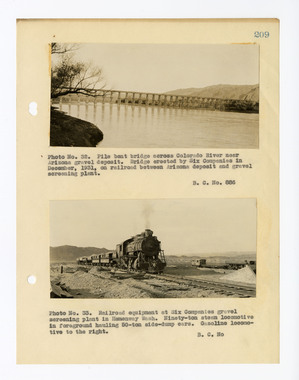
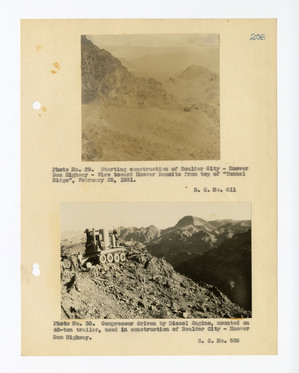
NARA Series: Boulder Canyon Project Series, 1948-1966. Record Group 48: Records of the Office of the Secretary of the Interior, 1826-2009. National Archives Identifier: 2292774
A Great Week
This week, I have been working on my presentation while continuing to work on the metadata. I consider it a great week particularly since my data was saved. 🙂
#CLIRWater Presentation
As is the case with my fellow fellows, this week has been spent preparing for my final presentation on what I have worked on this semester. Working on the presentation was an interesting experience, trying to balance information about the actual process of digitizing while also illuminating the materials in the collection proved tricky. It will be exciting to show the public examples of what materials have been digitized. It will also be a joy to spend time with my other colleagues who have been working on similar projects. The digitization process, as well as archiving, can be extremely lonely. Any chance to mingle with others and break up the isolation is wonderful.
Since I typically like to provide you all with a photo, please enjoy this lovely photo which begins the 1947 project history!
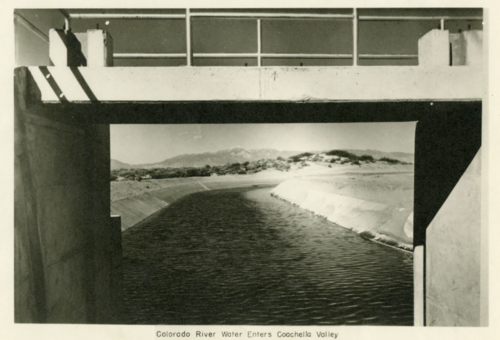
NARA Series: All-American Canal Project Histories, 1948-1954. Record Group 48: Records of the Office of the Secretary of the Interior, 1826-2009. National Archives Identifier: 2292770
Окончательное падение cwd00691
Comrades! Rejoice, for our glorious Hasselblad 501CM will be restored and shall join us in our final battle to capture cwd00691! The mechanical unit might be old and bogged down by dirty crumbling leather specks, but like our CLIRWater Motherland, it shall persist along our other decade-old hardware and put an end to that annoying Pauba Ranch map! Sure, we were set back multiple times going against the grain in the last 3 months, even with the employment of the newer, flashier Canon EOS Rebel T6 DSLR with its 600ppi setting, but we shall not surrender (because we need our paychecks) and we shall march right back to the gate of the Camera room! For the Noir Army is the strongest! Для Родины!
Presentation and processing.
As the date for our final presentation is set for Dec.12th, I have been thinking this week about what I am going to present. Actually there is quite a lot to talk about. Not only about the materials and information regarding Mr. John Seymour, but about the whole archival processing which is quite new to me. First, I learned that working with primary sources and processing the materials requires patience and a good organization plan. For the last month I have been organizing Mr. Seymour’s correspondence. I have unfolded, removed from envelops, placed in a folded acid free paper, and put in appropriate folders more then 1,000 letters! I still need to create a list of all the folders. It took some time, but it feels good that one of the series is almost completed.

Culminating Presentation
Calling All Celebrities
Let there be no doubt that Irving Wallace was a first-class self-promoter! Today, I came across a box entitled, “THE MAN: Unsigned carbons of celebrity mailing,” which contains copies of hundreds of letters that Wallace sent to noteworthy individuals along with advance copies of his new novel, The Man, in 1964. Wallace’s recipients were a varied bunch of political, literary, and artistic heavyweights, from Harry Truman and Lyndon Johnson to Jean-Paul Sartre, Martin Luther King, Jr. to comedian Jack Paar of The Tonight Show. Wallace even wrote to an aging Pablo Picasso in Cannes, declaring himself “an admirer” of the legendary painter’s work and insisting that Picasso need not reply to his letter. (Picasso was surely relieved).
Here’s the letter in full:
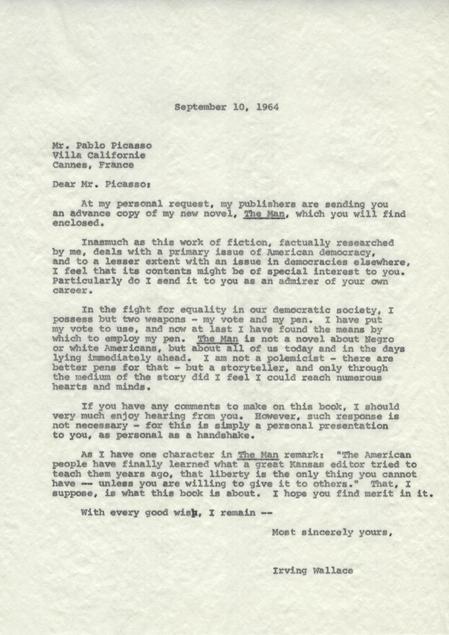
This box of letters underscores Wallace’s fearlessness–some would even say brazenness–in selling his work. As somebody who dedicated himself to a writing career at a young age, Wallace never hesitated to sing his own praises or expound on the importance of his work to any journalist who might listen; these activities were integral to his professional success and economic well-being. By 1964, following the huge success of The Chapman Report, Wallace appears to have decided that an ambitious writer needed an aggressive media strategy, and that an aggressive media strategy could only benefit from outreach to prominent cultural figures in the U.S. and Europe. (It’s also fair to say that Wallace was becoming impressed with his growing celebrity). Whether any of these individuals returned Wallace’s letter is another question, and one which I’ll be eager to find out.
Post-War Canal Maintenance: Part 2
Last week it was discussed that during World War 2, all non-essential maintenance on the All-American Canal was halted. By the end of the war, a large section of the banks of the canal had become overrun with vegetation such as willows, and arrow weeds. To combat these issues, an accelerated program of maintenance and rehabilitation was inaugurated in 1946. While last week we saw the maintenance on some of the gate rollers, this week are 2 photos showing how the overrun vegetation was managed.
Workers on amphibious vessels used flame throwers to burn up the excess flora along the banks of the canal. The photos below show this removal process, as well as give a close up look as to what the amphibious vessels looked like when out of water.

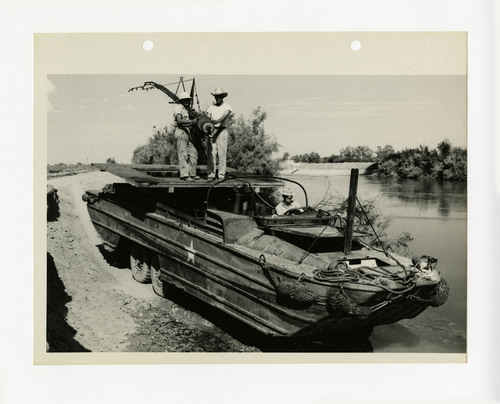
NARA Series: All-American Canal Project Histories, 1948-1954. Record Group 48: Records of the Office of the Secretary of the Interior, 1826-2009. National Archives Identifier: 2292770
Thanksgiving of 1975
The day before Thanksgiving is rather quiet at CCEPS and the Honnold Library. Most staff and students most likely travel already or prepare the food. I’m not traveling so I’m here enjoying the, as I would call, “easy finding parking day” on campus.
While looking through some stack of Mr. Seymour’s letters I found this small packet diary from 1975. That year Thanksgiving came on November 27th, so five days later than this year. There is no note on that day and I do not know where or with whom Mr. Seymour spent the day, but he must be somewhere since the next day he wrote “leave for home” and than “bus to C.C.” Well, safe travel everyone and have a great Thanksgiving day!

